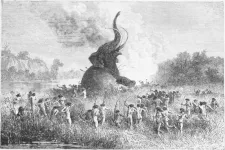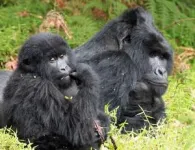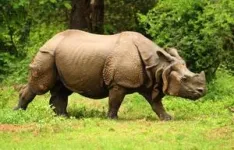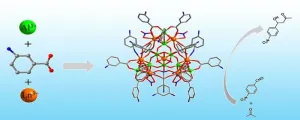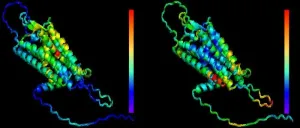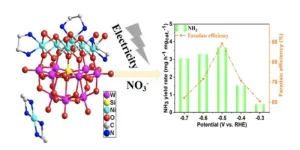(Press-News.org) About 100,000 years ago, the first modern humans migrated out of Africa in large numbers. They were eminent at adapting to new habitats, and they settled in virtually every kind of landscape - from deserts to jungles to the icy taiga in the far north.
Part of the success was human's ability to hunt large animals. With clever hunting techniques and specially built weapons, they perfected the art of killing even the most dangerous mammals.
But unfortunately, the great success of our ancestors came at the expense of the other large mammals.
It is well-known that numerous large species went extinct during the time of the world-wide colonization by modern humans. Now, new research from Aarhus University reveals that those large mammals that survived, also experienced a dramatic decline.
By studying the DNA of 139 living species of large mammals, the scientists have been able to show that abundances of almost all species fell dramatically about 50,000 years ago.
This is according to Jens-Christian Svenning, a professor and head of the Danish National Research Foundation's Center for Ecological Dynamics in a Novel Biosphere (ECONOVO) at Aarhus University, and the initiator of the study.
"We’ve studied the evolution of large mammalian populations over the past 750,000 years. For the first 700,000 years, the populations were fairly stable, but 50,000 years ago the curve broke and populations fell dramatically and never recovered,” he says, and continues:
"For the past 800,000 years, the globe has fluctuated between ice ages and interglacial periods about every 100,000 years. If climate was the cause, we should see greater fluctuations when the climate changed prior to 50.000 years ago. But we don't. Humans are therefore the most likely explanation.”
Who killed the large mammals?
For decades, scientists have debated what is behind the extinction or rapid decline of large mammals over the past 50,000 years.
On one side are scientists who believe that rapid and severe fluctuations in the climate are the main explanation. For example, they believe that the woolly mammoth went extinct because the cold mammoth steppe largely disappeared.
On the opposite side are a group who believe that the prevalence of modern humans (Homo sapiens) is the explanation. They believe that our ancestors hunted the animals to such an extent that they either became completely extinct or were severely decimated.
So far, some of the most important evidence in the debate has been fossils from the past 50,000 years. They show that the strong, selective extinction of large animals in time and space roughly matches the spread of modern humans around the globe. Therefore, the extinction of animals can hardly be linked to climate. Nevertheless, the debate continues.
The new study presents brand new data that sheds new light on the debate. By looking at the DNA of 139 large living mammals – species that have survived for the past 50,000 years without becoming extinct – the researchers can show that the populations of these animals have also declined over the period. This development seems to be linked to the spread of humans and not climate change.
DNA contains the long-term history of the species
In the past 20 years, there has been a revolution within DNA sequencing. Mapping entire genomes has become both easy and inexpensive, and as a result the DNA of many species has now been mapped.
The mapped genomes of species all over the globe are freely accessible on the internet – and this is the data that the research group from Aarhus University has utilized, explains assistant professor Juraj Bergman, the lead researcher behind the new study.
“We’ve collected data from 139 large living mammals and analysed the enormous amount of data. There are approximately 3 billion data points from each species, so it took a long time and a lot of computing power,” he says and continues:
"DNA contains a lot of information about the past. Most people know the tree of life, which shows where the different species developed and what common ancestors they have. We’ve done the same with mutations in the DNA. By grouping the mutations and building a family tree, we can estimate the size of the population of a specific species over time.
The larger the population of an animal, the more mutations will occur. It’s really a question of simple mathematics. Take elephants, for example. Every time an elephant is conceived, there’s a chance that a number of mutations will occur, and it will pass these on to subsequent generations. More births means more mutations.”
The large mammals
The 139 large mammals examined in the study are all species that exist today. They include elephants, bears, kangaroos and antelopes among others.
It is estimated that there are 6,399 species of mammals on the Earth, but the 139 extant megafauna were selected in this study to test how their populations changed over the past 40,000 to 50,000 years, when similar large animals went extinct.
The large mammals are also called megafauna – and are defined as animals weighing more than 44 kg when fully grown. Humans are therefore also considered megafauna. In the study, however, the researchers examined species weighing as little as 22 kg, so that all continents have been represented - except Antarctica.
Source: Journal of Mammalogy
Looking at the neutral parts of the DNA
However, the size of the elephant population is not the only thing that affects the number of mutations.
If the area in which elephants live suddenly dries up, the animals come under pressure – and this affects the composition of mutations. The same applies if two isolated groups of elephants suddenly meet and mix genes.
If not only the size of the population affects how many mutations occur, you would think that the results are rather uncertain. But this is not the case, explains Juraj Bergman.
"Only 10 per cent of mammalian genomes consist of active genes. Great selection pressure from the environment or migration will primarily lead to mutations in the genes. The remaining 90 percent, on the other hand, are more neutral,” he says, and continues:
"We have therefore examined mutations in those parts of the genome that are least susceptible to the environment. These parts primarily indicate something about the size of the population over time.”
The woolly mammoth is an atypical case
Much of the debate about what caused the large animals to either become extinct or decline has centered around the woolly mammoth. But this is a bad example because the majority of the megafauna species that went were associated with temperate or tropical climates, as Jens-Christian Svenning explains.
“The classic arguments for the climate as an explanatory model are based on the fact that the woolly mammoth and a number of other species associated with the so-called "mammoth steppe" disappeared when the ice melted and the habitat type disappeared,” he says, and continues:
"This is basically an unsatisfactory explanatory model, as the vast majority of the extinct megafauna species of the period did not live at all on the mammoth steppe. They lived in warm regions, such as temperate and tropical forests or savannahs. In our study, we also show a sharp decline during this period in populations of the many megafauna species that survived and come from all sorts of different regions and habitats.”
The final full stop in the debate has probably yet to be set, but Jens-Christian Svenning finds it difficult to see how the arguments for the climate as an explanation can continue.
"It seems inconceivable that it is possible to come up with a climate model that explains how, across all continents and groups of large animals, there have been extinctions and continuous decline since about 50,000 years ago. And how this selective loss of megafauna is unique for the past 66 million years, despite huge climate change
Given the rich data we now have, it’s also hard to deny that instead it is because humans spread across the globe from Africa and subsequently grew in population.”
About the research
Type of study:
Statistical modelling
External funding:
The study is supported by the Villum Foundation (grant 16549), the Danish National Research Foundation (DNRF173) and the EU Horizon 2020 programme.
Conflicts of interest:
The researchers declare that there are no conflicts of interest in connection with this research. END
People, not the climate, caused the decline of the giant mammals
For years, scientists have debated whether humans or the climate have caused the population of large mammals to decline dramatically over the past several thousand years. A new study from Aarhus University confirms that climate cannot be the explanation
2023-12-14
ELSE PRESS RELEASES FROM THIS DATE:
Children who are sedentary may have a higher risk of heart attack or stroke later in life
2023-12-14
WASHINGTON—Children who are physically inactive may have high cholesterol in early adulthood and subsequent heart health issues in their mid-forties, according to new research published in The Journal of Clinical Endocrinology & Metabolism.
High cholesterol during childhood has been associated with early signs of heart disease when individuals reach their mid-twenties and an increased risk of premature cardiovascular death in their mid-forties. Several clinical trials aimed at lowering cholesterol levels in the youth population have had minimal ...
Cockroaches can transmit antimicrobial resistance genes between groups
2023-12-14
Washington, D.C.—A new paper describes a study of antimicrobial resistance (AMR) transmission among cockroaches, with implications for AMR transmission in humans. The study was published in mSystems, a journal of the American Society for Microbiology.
AMR represents a serious threat to the health of humans and other animals. With fewer and fewer drugs being effective against some microbial pathogens, infections have become increasingly difficult to treat. Theoretical modeling has been used to explore the spread of AMR through the microbiome of the symbiotic, or nonpathogenic, gut of animals. The present study ...
Three novel inorganic clusters accelerate ‘one of the most important’ chemical reactions
2023-12-14
Perfume, rubbing alcohol, a cholesterol medication and even biological processes all depend on a chemical process called the aldol reaction. The reaction primarily combines compounds to form carbon-carbon bonds, which are incredibly strong and provide a molecule with stability. Catalyst clusters made of aluminum and oxygen typically help accelerate this reaction, but clusters that also include rare earth elements could offer more desirable and synergistic properties, according to a team of researchers based in China.
The team developed three such clusters, ...
Unlocking the human genome: Innovative machine learning tool predicts functional consequences of genetic variants
2023-12-14
New York, NY [December 14, 2023]—In a novel study, researchers from the Icahn School of Medicine at Mount Sinai introduced LoGoFunc, an advanced computational tool that predicts pathogenic gain- and loss-of-function variants across the genome.
Unlike current methods that predominantly focus on loss of function, LoGoFunc distinguishes among different types of harmful mutations, offering potentially valuable insights into diverse disease outcomes. The findings were described in the November 30 online issue of Genome Medicine ...
A new catalyst opens efficient conversion from nitrate pollution to valuable ammonia
2023-12-14
Pollution spewing from a booming global economy poses a number of different threats to human health. Researchers from Zhongyuan University of Technology proposed a new possible avenue to efficiently convert nitrate, a widespread water pollutant, back to valuable ammonia. In their recently published study, the team outlined a novel path to efficiently convert nitrate to ammonia using metal-added polyoxometalate as the catalyst under mild operating conditions.
The study was published December 8 in Polyoxometalates.
In the past few decades, a number of methods have been deployed ...
High cholesterol caused by childhood sedentariness could be reversed with light physical activity
2023-12-14
Strictly embargoed until 0900 ET Thursday 14 December 2023
Increased sedentary time in childhood can raise cholesterol levels by two thirds as an adult, leading to heart problems and even premature death - but a new study has found light physical activity may completely reverse the risks and is far more effective than moderate-to-vigorous physical activity.
The study was conducted in collaboration between the University of Exeter, University of Eastern Finland, and University of Bristol and published in The Journal of Clinical Endocrinology & Metabolism. Researchers used data from the University of Bristol study Children of the 90s (also known as the Avon Longitudinal Study of Parents ...
Menstrual cycles affect day-to-day suicide risk, UIC researchers find
2023-12-14
Female patients with a history of suicidality experience an increased risk of suicidal ideation or suicidal planning in the days surrounding menstruation, according to a new study by researchers at the University of Illinois Chicago.
In the first longitudinal study of how suicidal thoughts and related symptoms fluctuate across the menstrual cycle, UIC researchers identified when some female patients are at the highest risk, offering new guidance for clinicians about when to focus interventions with suicidal patients.
“As clinicians, we feel responsible for keeping our patients safe from a suicide attempt, but we often don’t have much information about when we need ...
A novel low-cost unmanned aerial vehicle platform for electrical transmission line inspection
2023-12-14
Electricity is an indispensable resource for our daily lives; it powers our homes, industries, and agriculture, among other things. Electricity is generated in power plants that are often located in remote areas due to safety and environmental concerns. The generated electricity is then transported to residential and industrial areas through transmission lines. However, these remote locations pose challenges in terms of harsh environments that can easily damage the transmission lines. Therefore, regular inspection and maintenance of these lines are ...
Popular blood thinner associated with higher risk of bleeding complications
2023-12-14
When diagnosed with a blood clot or atrial fibrillation, patients are often prescribed anticoagulants, or blood thinners, to prevent a future clot.
In a study of the three most commonly prescribed blood thinners, the oral anticoagulant rivaroxaban, known by the brand name Xarelto, was associated with a significantly higher risk of bleeding complications than apixaban (brand name Eliquis) and warfarin for patients with blood clots or atrial fibrillation.
The findings, reported at the 2023 American Society ...
Study shows tree nuts as snacks reduces metabolic syndrome risk in Millenials
2023-12-14
DAVIS, CA, December 14, 2023 – A recent study published online in the journal, Nutrients[1], suggests daily tree nut consumption reduces the risk of metabolic syndrome (MetSx) by improving waist circumference, lipid biomarkers, and/or insulin levels, without requiring calorie restriction, in young adults.
In a randomized, parallel arm, dietary intervention study design, researchers at Vanderbilt University Medical Center enrolled 84 men and women, ages 22-36, most of whom were either overweight or obese (BMI 24.5 to 34.9 kg/m2) and had at least one MetSx risk factor ...
LAST 30 PRESS RELEASES:
People with “binge-watching addiction” are more likely to be lonely
Wild potato follows a path to domestication in the American Southwest
General climate advocacy ad campaign received more public engagement compared to more-tailored ad campaign promoting sustainable fashion
Medical LLMs may show real-world potential in identifying individuals with major depressive disorder using WhatsApp voice note recordings
Early translational study supports the role of high-dose inhaled nitric oxide as a potential antimicrobial therapy
AI can predict preemies’ path, Stanford Medicine-led study shows
A wild potato that changed the story of agriculture in the American Southwest
Cancer’s super-enhancers may set the map for DNA breaks and repair: A key clue to why tumors become aggressive and genetically unstable
Prehistoric tool made from elephant bone is the oldest discovered in Europe
Mineralized dental plaque from the Iron Age provides insight into the diet of the Scythians
Salty facts: takeaways have more salt than labels claim
When scientists build nanoscale architecture to solve textile and pharmaceutical industry challenges
Massive cloud with metallic winds discovered orbiting mystery object
Old diseases return as settlement pushes into the Amazon rainforest
Takeaways are used to reward and console – study
Velocity gradients key to explaining large-scale magnetic field structure
Bird retinas function without oxygen – solving a centuries-old biological mystery
Pregnancy- and abortion-related mortality in the US, 2018-2021
Global burden of violence against transgender and gender-diverse adults
Generative AI use and depressive symptoms among US adults
Antibiotic therapy for uncomplicated acute appendicitis
Childhood ADHD linked to midlife physical health problems
Patients struggle to measure blood pressure at home
A new method to unlock vast lithium stores
Scientists unveil “dissolution barocaloric” cooling, opening new path to zero-carbon refrigeration
Microplastics in the atmosphere: Higher emissions from land areas than from the ocean
Metal clumps in quantum state: Vienna research team breaks records
PolyU develops new human-safe magnetorheological fibres, leading innovations in smart wearable textiles
Rice establishes Global Brain Economy Initiative in Davos, aligned with new report on brain health and AI
Quantum error correction with logical qubits
[Press-News.org] People, not the climate, caused the decline of the giant mammalsFor years, scientists have debated whether humans or the climate have caused the population of large mammals to decline dramatically over the past several thousand years. A new study from Aarhus University confirms that climate cannot be the explanation
